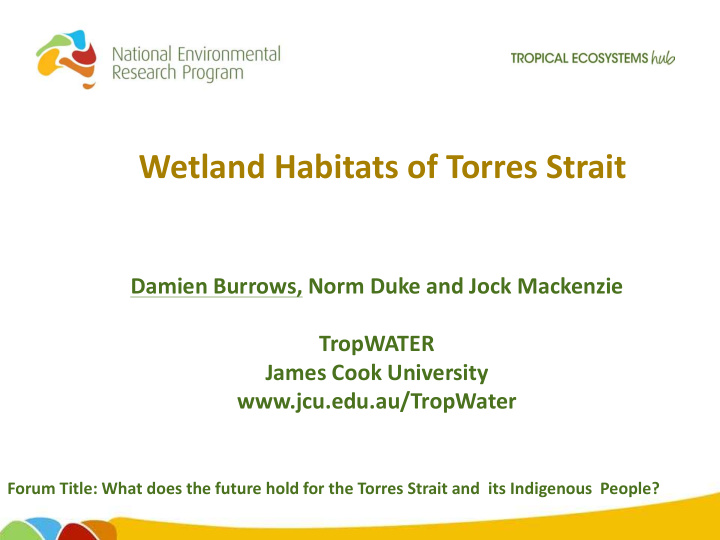



Wetland Habitats of Torres Strait Damien Burrows, Norm Duke and Jock Mackenzie TropWATER James Cook University www.jcu.edu.au/TropWater Forum Title: What does the future hold for the Torres Strait and its Indigenous People?
RELEVANCE OF WORK Values of wetlands • Tidal and freshwater wetlands important for habitat and fishery production • Provide drinking water • Provide a range of ecosystem services and cultural uses • Provide coastal protection against storm surges Status of wetlands • They are very poorly known/ documented in Torres Strait • No information on condition, extent, status. • Proper mgt requires this knowledge • Numerous threats exist and need to be understood and managed
Status of Wetlands in Torres Strait RESULTS Biodiversity ~ 124 wetland species, including >39 mangrove species – 2 new mangrove species for Australia & 2 new species for Torres Strait. - Many new records on each island visited Extent 31,390 ha of wetland area within Torres Strait, comprising 21 vegetation communities of which 3 are unique to the region. 83% of wetlands in Torres Strait are tidal, mostly mangrove communities (Boigu and Boigu senior ranger Nelson Gibuma standing next to the only Sonneratia ovata tree known in Australia Saibai islands have the largest areas
Surveys conducted by boat, helicopter and on foot Knowledge exchange with island communities.
Shoreline Video Assessment – 12 islands thus far, >500km Shoreline video survey tracks (Red/Pink line) of 7 Islands displayed
Biomass – Blue Carbon RESULTS Seaward Zone Landward Zone Graph of mangrove forest biomass, showing above and below ground carbon storage for each major mangrove vegetation community. R= Rhizophora forest, B = Bruguiera forest, C_B = Mixed Ceriops and Bruguiera forest, C = Ceriops forest and C/AM = Ceriops with emergent Avicennia Mean Mangrove Biomass = 360t/Ha* forest. AGB = Above-ground biomass, BGB= Below-ground = 268tC/Ha Carbon Storage biomass *Data from Boigu & Saibai Islands
FRESHWATER HABITATS AND FAUNA More limited compared to mangrove habitat • • Paucity of published data (local information and unpublished data very important) • Freshwater turtles anecdotally reported from Horn, Badu, Mua, Erub and Saibai – only Saibai confirmed • Native water rat only known from road kill specimen at Badu Recording exotic flora and fauna (deer, pigs, cane toads) and their impact • • 31 fish species recorded from freshwater habitats on 7 islands recorded • 2 exotic species – mosquitofish (Thursday Is.) and climbing perch (Saibai, Boigu) • Key islands Saibai, Boigu, Mua, POW, Horn
APPLICATION OF WORK Koi Mai – the big well, Boigu • Understanding and managing changes to these habitats •Understanding and reducing impacts on these habitats •There are numerous drivers of change/impact that vary widely across the islands. Melaleuca dieback – seawater intrusion
OBSERVED DRIVERS OF CHANGE Obviously human related Shoreline Mangroves affected by Drivers of Change 20 • Clearing and cutting 18 • Root burial – dredge spoil 16 Direct % Mangrove Shoreline Human 14 • Pollutants – albino mutations in Rhizophora Impacts 12 • Fire (freshwater wetlands) 10 Natural/ Not Obviously human related 8 Climate Change • Shoreline Erosion 6 impacts 4 • Mangrove upland migration (SLR) 2 • Storms damage – wind, lightning & sediment 0 deposition Badu Mua Mabuiag Turnagain Dauan Boigu (Buru) • Feral animals & weeds (pigs, deer, pond apple) Shoreline erosion, Masig island Mangrove dieback due to root burial from sand deposition caused by storm waves or storm surge, North-east Mua Is.
PREDICTED CLIMATE CHANGE IMPACTS More severe storms Increased lightning and wind disturbance in mangroves – loss of ecosystem integrity Sea Level Rise Loss of seaward mangrove extent and mangrove encroachment into saline/freshwater wetlands – already occurring. Increased temperature and altered rainfall • Species migrations from New Guinea • Mangrove species range extension • Ecotone shift • Pest fish species into wetlands e.g. Climbing perch • Loss of ephemeral pools • Increased fire risk to wetlands
FUTURE DIRECTIONS Workplan • Shoreline and Mangrove survey Warraber, Erub, Ugar and Murray Islands (August) •Inner Islands (eg, POW, Horn) are also hopeful •Pursue freshwater fauna on Mua, Saibai and inner islands Goals •Improved condition and mgt of wetlands •Establish mangrove, shoreline and freshwater monitoring as part of ranger routine workplans •Potential for blue carbon, given these mangroves are in relatively good condition.
THANK YOU Ac kno wle dg e me nts Sta ff o f the T o rre s Stra it Re g io na l Autho rity, L a nd a nd Se a Ma na g e me nt Unit Ra ng e rs, e lde rs, PBC a nd Co unc il sta ff o n the isla nds we visite d Email: damien.burrows@jcu.edu.au Visit www.jcu.edu.au/TropWATER
Recommend
More recommend